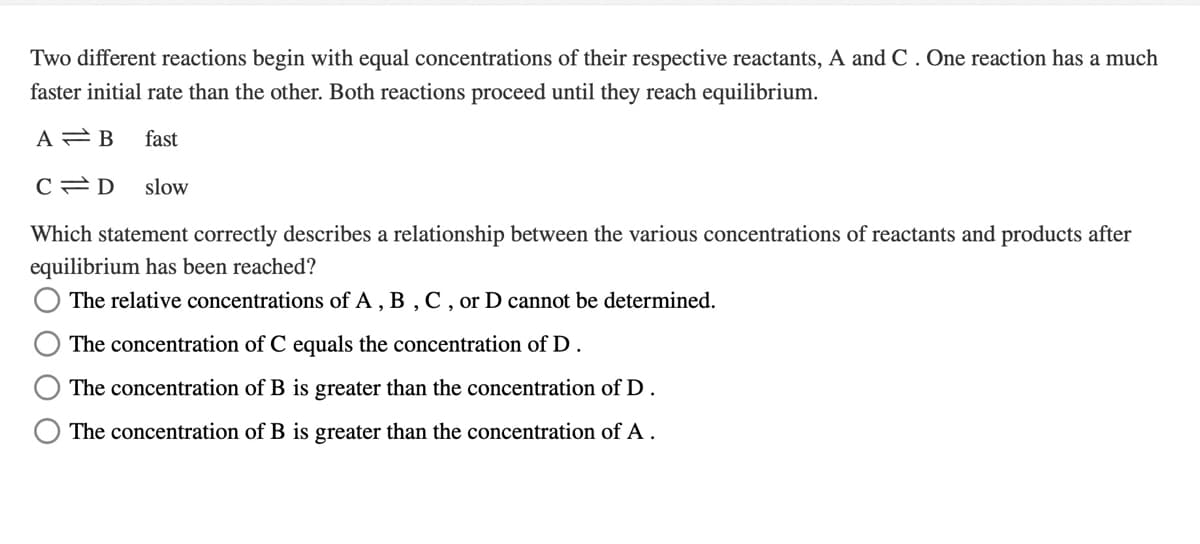Two different reactions begin with equal concentrations of their respective reactants, A and C. One reaction has a much faster initial rate than the other. Both reactions proceed until they reach equilibrium. A B fast slow Which statement correctly describes a relationship between the various concentrations of reactants and products after equilibrium has been reached? The relative concentrations of A , B , C, or D cannot be determined. The concentration of C equals the concentration of D. The concentration of B is greater than the concentration of D. The concentration of B is greater than the concentration of A.
Two different reactions begin with equal concentrations of their respective reactants, A and C. One reaction has a much faster initial rate than the other. Both reactions proceed until they reach equilibrium. A B fast slow Which statement correctly describes a relationship between the various concentrations of reactants and products after equilibrium has been reached? The relative concentrations of A , B , C, or D cannot be determined. The concentration of C equals the concentration of D. The concentration of B is greater than the concentration of D. The concentration of B is greater than the concentration of A.
General Chemistry - Standalone book (MindTap Course List)
11th Edition
ISBN:9781305580343
Author:Steven D. Gammon, Ebbing, Darrell Ebbing, Steven D., Darrell; Gammon, Darrell Ebbing; Steven D. Gammon, Darrell D.; Gammon, Ebbing; Steven D. Gammon; Darrell
Publisher:Steven D. Gammon, Ebbing, Darrell Ebbing, Steven D., Darrell; Gammon, Darrell Ebbing; Steven D. Gammon, Darrell D.; Gammon, Ebbing; Steven D. Gammon; Darrell
Chapter14: Chemical Equilibirum
Section: Chapter Questions
Problem 14.25QP: The following reaction is earned out at 500 K in a container equipped with a movable piston....
Related questions
Question

Transcribed Image Text:Two different reactions begin with equal concentrations of their respective reactants, A and C . One reaction has a much
faster initial rate than the other. Both reactions proceed until they reach equilibrium.
A B
fast
slow
Which statement correctly describes a relationship between the various concentrations of reactants and products after
equilibrium has been reached?
The relative concentrations of A , B , C, or D cannot be determined.
The concentration of C equals the concentration of D.
The concentration of B is greater than the concentration of D.
The concentration of B is greater than the concentration of A.
Expert Solution
This question has been solved!
Explore an expertly crafted, step-by-step solution for a thorough understanding of key concepts.
This is a popular solution!
Trending now
This is a popular solution!
Step by step
Solved in 2 steps with 1 images

Knowledge Booster
Learn more about
Need a deep-dive on the concept behind this application? Look no further. Learn more about this topic, chemistry and related others by exploring similar questions and additional content below.Recommended textbooks for you

General Chemistry - Standalone book (MindTap Cour…
Chemistry
ISBN:
9781305580343
Author:
Steven D. Gammon, Ebbing, Darrell Ebbing, Steven D., Darrell; Gammon, Darrell Ebbing; Steven D. Gammon, Darrell D.; Gammon, Ebbing; Steven D. Gammon; Darrell
Publisher:
Cengage Learning

Chemistry: An Atoms First Approach
Chemistry
ISBN:
9781305079243
Author:
Steven S. Zumdahl, Susan A. Zumdahl
Publisher:
Cengage Learning


General Chemistry - Standalone book (MindTap Cour…
Chemistry
ISBN:
9781305580343
Author:
Steven D. Gammon, Ebbing, Darrell Ebbing, Steven D., Darrell; Gammon, Darrell Ebbing; Steven D. Gammon, Darrell D.; Gammon, Ebbing; Steven D. Gammon; Darrell
Publisher:
Cengage Learning

Chemistry: An Atoms First Approach
Chemistry
ISBN:
9781305079243
Author:
Steven S. Zumdahl, Susan A. Zumdahl
Publisher:
Cengage Learning


Chemistry
Chemistry
ISBN:
9781305957404
Author:
Steven S. Zumdahl, Susan A. Zumdahl, Donald J. DeCoste
Publisher:
Cengage Learning

Chemistry: The Molecular Science
Chemistry
ISBN:
9781285199047
Author:
John W. Moore, Conrad L. Stanitski
Publisher:
Cengage Learning

Introductory Chemistry: A Foundation
Chemistry
ISBN:
9781337399425
Author:
Steven S. Zumdahl, Donald J. DeCoste
Publisher:
Cengage Learning